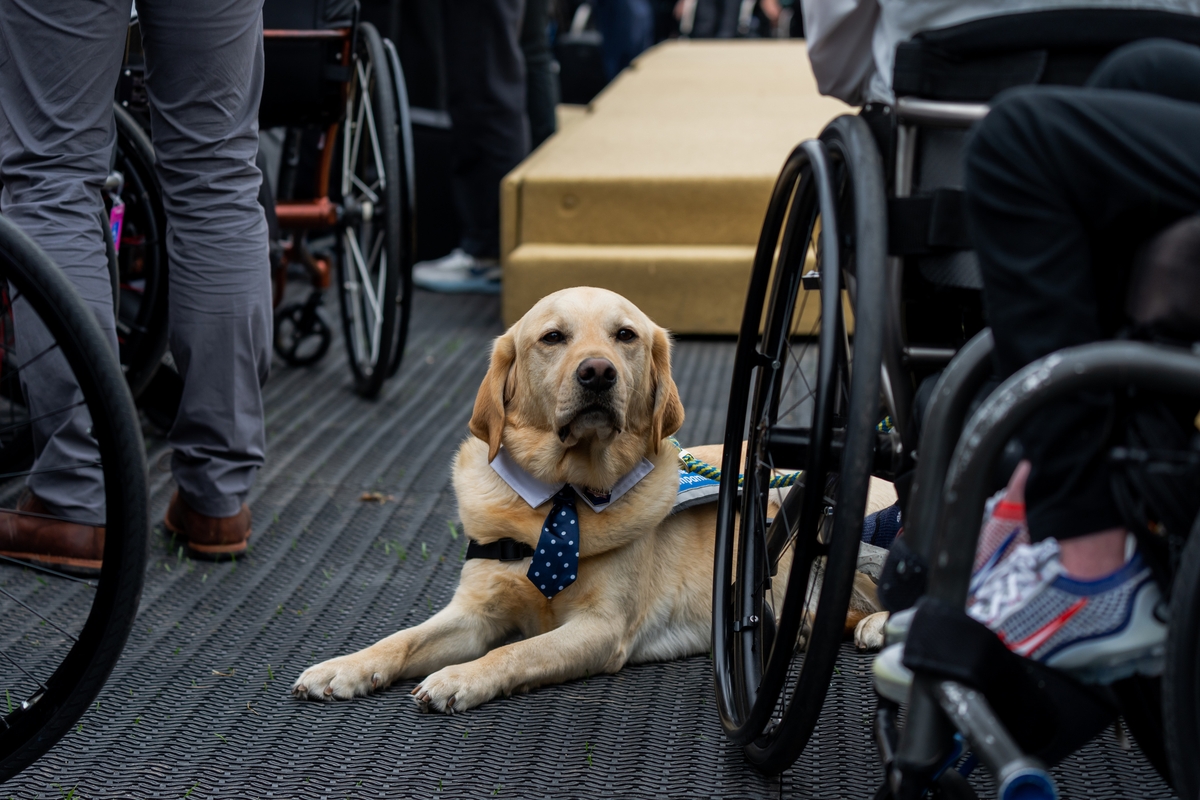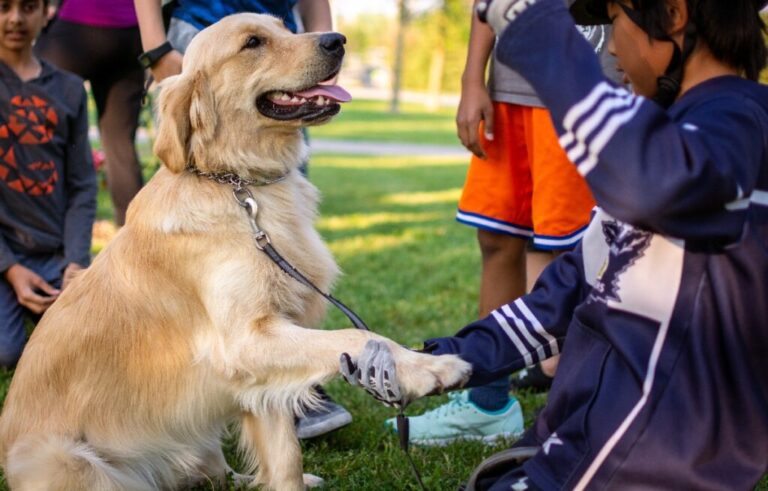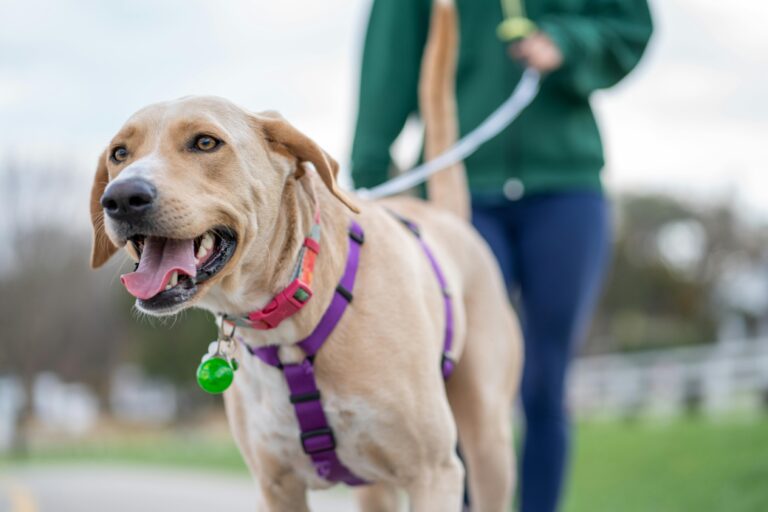Unlocking Their Abilities: Training Labrador Retrievers for Service or Work
Labrador Retrievers: The Perfect Service Dogs
When it comes to service or work roles, Labrador Retrievers are often considered the perfect choice. Their exceptional characteristics and versatility make them highly suitable for these important tasks.
Characteristics of Labrador Retrievers
Labrador Retrievers possess a unique set of traits that make them excellent candidates for service dog work. Known for their intelligence, adaptability, and eagerness to please, Labradors are highly trainable and excel in various tasks. Their friendly and outgoing nature allows them to establish strong bonds with their handlers and interact effectively with people from all walks of life.
Additionally, Labrador Retrievers are known for their loyalty and reliability. They are dependable and can handle the demands of service work with great dedication. Their even-tempered and patient disposition enables them to remain calm and composed in challenging situations, making them ideal companions for individuals who require assistance or support.
Their medium to large size and sturdy build also contribute to their suitability as service dogs. Labradors have the physical strength and stamina necessary to perform a wide range of tasks, such as pulling objects, providing stability, and navigating various environments.
The Versatility of Labrador Retrievers in Service Work
Labrador Retrievers are incredibly versatile when it comes to service work. They are capable of performing a wide range of tasks, making them valuable assets in various settings. Whether it’s guiding individuals with visual impairments, assisting individuals with mobility challenges, or providing emotional support, Labradors can adapt to different roles with ease.
Labradors’ intelligence and trainability enable them to learn and execute complex commands and tasks effectively. They can be trained to open doors, retrieve items, alert to sounds or seizures, and offer comfort during stressful situations. Their gentle and patient nature allows them to work with individuals of all ages, including children and the elderly.
Labrador Retrievers are also commonly used as therapy dogs due to their friendly and comforting presence. They have the ability to provide emotional support and companionship to those in need, particularly in hospitals, nursing homes, and other therapeutic settings.
Labrador Retrievers’ versatility in service work, combined with their exceptional temperament and intelligence, makes them highly sought after for a variety of roles. They excel as service dogs, search and rescue dogs, police dogs, and more, showcasing their adaptability and intelligence in serving the needs of others.
Labrador Retrievers are not the only breed used for service dog training, but their exceptional qualities and widespread popularity have made them a top choice for many organizations and individuals. Other breeds, such as Golden Retrievers, Labradoodles, and Poodles, are also commonly utilized for service work due to their compatible traits and trainability.
By harnessing the unique characteristics and capabilities of Labrador Retrievers, individuals can unlock their full potential as service dogs, providing invaluable assistance and support to those in need.
Training Labrador Retrievers for Service or Work
When it comes to training Labrador Retrievers for service or work, there are key aspects to consider to ensure their success in these important roles. This section will cover the importance of early socialization, basic commands for service dogs, and the reinforcement of positive behaviors.
Importance of Early Socialization
Early socialization plays a vital role in the training of Labrador Retrievers for service or work. It is crucial to expose them to various environments, noises, and people from a young age to ensure they remain comfortable and focused throughout their training. Early socialization helps them develop the confidence and adaptability necessary for their future tasks (American Kennel Club). By gradually introducing them to new experiences and positively reinforcing their responses, you can help them become well-rounded and confident service dogs.
Basic Commands for Service Dogs
Teaching Labrador Retrievers basic commands is an essential part of their training. These commands include sit, stay, down, and come. These foundational commands provide the framework for more advanced training and enable them to assist their handlers effectively. Consistency and positive reinforcement are key when teaching these commands. By using rewards such as treats or praise, you can encourage and reinforce the desired behaviors (American Kennel Club).
Reinforcing Positive Behaviors
Reinforcing positive behaviors is a fundamental aspect of training Labrador Retrievers for service or work. Positive reinforcement involves rewarding your dog for exhibiting desired behaviors. It can be as simple as praise, treats, or playtime. By consistently rewarding positive behaviors, you reinforce the behavior you want to see more of in your Labrador Retriever. This positive reinforcement helps build a strong bond between the dog and its handler, enhancing their working relationship and motivation to perform their tasks effectively (American Kennel Club).
The training process for Labrador Retrievers requires patience, consistency, and positive reinforcement. It is important to remember that each dog is unique, and training methods may need to be tailored to their individual needs and abilities. By focusing on early socialization, teaching basic commands, and reinforcing positive behaviors, you can lay a solid foundation for their successful service or work roles. For more training tips and guidance, consider consulting a professional dog trainer who specializes in service dog training.
Specialized Training for Labrador Retrievers
Training Labrador Retrievers for service or work requires a targeted approach to ensure they can perform their specific tasks effectively. Here, we will explore two important aspects of specialized training: task-specific commands and training for calmness and focus in different environments.
Task-Specific Commands
When training Labrador Retrievers for service or work, it is important to teach them not only basic commands but also specialized commands that match the tasks they will need to perform in their service roles. For example, a service dog trained to assist individuals with mobility issues may need to learn commands like retrieving objects, opening doors, or providing support by leaning against their handler when needed.
By using positive reinforcement techniques, such as treats or praise, you can effectively communicate and reinforce these task-specific commands. Consistency and repetition are key in teaching your Labrador Retriever to associate specific commands with the desired actions. It is recommended to work with a professional trainer experienced in service dog training to ensure proper training techniques and effective outcomes.
Training for Calmness and Focus in Different Environments
Service dogs need to be able to work calmly and attentively in a variety of environments. To prepare Labrador Retrievers for their service duties, it is crucial to expose them to various environments, noises, and people from an early age. This process, known as socialization, helps them become comfortable and focused even in unfamiliar or busy settings.
During training sessions, gradually introduce your Labrador Retriever to different environments, starting with less stimulating ones and gradually increasing the level of distraction. This helps them develop the ability to remain calm, focused, and responsive despite external stimuli.
Positive reinforcement is essential during this training phase. Reward your Labrador Retriever for maintaining calm behavior and attentiveness in different environments. By associating positive experiences with various situations, your dog will learn to adapt and stay focused on their tasks.
It is important to note that specialized training for Labrador Retrievers should be tailored to the specific service or work they will be performing. Each task may require different training techniques and approaches. Working closely with professional trainers who specialize in service dog training can provide invaluable guidance and ensure the best possible outcomes.
By providing your Labrador Retriever with task-specific training and teaching them to remain calm and focused in a range of environments, you are equipping them with the skills needed to excel in their service or work roles. Harnessing their intelligence, trainability, and natural aptitude, Labrador Retrievers have proven to be exceptional partners in various service and work capacities.
The Bond Between Labrador Retrievers and Handlers
One of the most remarkable aspects of training Labrador Retrievers for service or work is the deep bond that develops between the dogs and their handlers. This bond is essential for the success of their partnership, as it enhances communication, trust, and teamwork, ultimately leading to effective assistance and support.
The Story of Kane: A Labrador Retriever Service Dog
An inspiring example of this bond is the story of Kane, a Labrador Retriever who serves as a trained service dog for his handler, a veteran suffering from PTSD. Kane’s story, shared by The Dog House LLC, showcases the powerful connection that can develop between a Labrador Retriever service dog and their handler.
Kane’s handler, through rigorous training and support, has formed an unbreakable bond with him. This bond provides emotional comfort and assistance, helping the handler navigate daily life with more confidence and stability. Kane’s presence and dedication have made a tremendous impact on his handler’s life, highlighting the transformative power of the human-canine relationship.
Building an Emotional Connection
Training Labrador Retrievers for service or work involves not only teaching specific tasks but also fostering a strong emotional connection and understanding between the dog and their handler. Labrador Retrievers are known for their intelligence, adaptability, and eagerness to please, making them well-suited for building strong emotional bonds with their handlers in service work (AKC).
To build this bond, handlers focus on positive reinforcement techniques, patience, and consistent training. By consistently rewarding desired behaviors and providing ample opportunities for social interaction and play, handlers create an environment that fosters trust, loyalty, and mutual understanding.
Regular training sessions, combined with everyday activities and experiences, allow Labrador Retrievers and their handlers to develop a shared language and a deep sense of companionship. Through this process, the dog becomes attuned to their handler’s needs, providing them with the support and assistance required for their specific service or work role.
The emotional connection between Labrador Retrievers and their handlers goes beyond the tasks they perform. These dogs become beloved companions and sources of comfort and emotional support, enhancing the overall well-being of their handlers.
By focusing on building a strong bond, handlers can unlock the full potential of their Labrador Retrievers in service or work roles. The partnership between a Labrador Retriever and their handler is a testament to the incredible bond that can form between humans and dogs and the positive impact it can have on both lives involved.
Labrador Retrievers: A Popular Choice for Service Work
Labrador Retrievers are widely recognized as the most popular breed for service dog work, and for good reason. Their incredible versatility, friendliness, and intelligence make them an ideal choice for a range of service tasks. Whether it’s guiding individuals with visual impairments, assisting those with mobility challenges, or providing emotional support, Labrador Retrievers excel in various service roles (American Kennel Club).
Traits That Make Labradors Suitable for Service Dog Roles
Labrador Retrievers possess a number of traits that make them well-suited for service work. These characteristics include:
-
Intelligence: Labrador Retrievers are highly intelligent and known for their ability to quickly learn and understand complex tasks. Their sharp minds allow them to effectively perform a wide range of service duties.
-
Trainability: Labradors have a strong desire to please their handlers, making them highly trainable. This eagerness, combined with their intelligence, makes them quick learners and adaptable to various training techniques.
-
Versatility: Labradors are incredibly versatile, making them suitable for a wide range of service roles. They can assist individuals with physical disabilities, detect medical conditions, provide emotional support, and even perform search and rescue missions.
-
Friendliness and Calmness: Labradors have a friendly and gentle nature, which is essential when working closely with individuals who may have physical or emotional challenges. Their calm demeanor allows them to remain composed in various environments and interact positively with people of all ages.
-
Physical Abilities: Labradors are known for their athleticism and endurance. Their strong bodies and robust build enable them to perform physically demanding tasks, such as pulling wheelchairs or navigating challenging terrains.
Other Breeds Used for Service Dog Training
While Labrador Retrievers are the most popular choice, other breeds are also utilized for service dog training. These include Golden Retrievers, Labradoodles, and Poodles, among others (New Life K9s). These breeds share similar traits with Labradors, such as intelligence, trainability, and a friendly temperament, which make them well-suited for service work. The specific breed selected for service training often depends on the individual’s needs and the tasks they require assistance with.
When it comes to service work, Labrador Retrievers continue to be a popular choice due to their exceptional qualities and proven track record in various service and work roles. Their intelligence, adaptability, and eagerness to please make them invaluable companions and helpers to individuals with disabilities or specific needs. Whether it’s guiding, assisting, or providing emotional support, Labrador Retrievers consistently demonstrate their remarkable abilities and unwavering dedication to their handlers.
The Training Process for Service Dogs
Training a Labrador Retriever to become a service dog requires time, effort, and dedication. It is not a quick or easy process, but with patience and consistency, you can help your Labrador Retriever develop the skills needed for service or work.
Time and Effort Required for Training
Training a dog to be a service animal typically takes at least 120 hours of training over a period of at least six months, with at least 30 hours of training required in public places (New Life K9s). The training process involves teaching the dog specific tasks that assist with a person’s disability. These tasks are personalized based on the individual’s needs to help mitigate specific symptoms. It’s important to note that training requirements may vary depending on the specific service or work the Labrador Retriever will be performing.
Consistency is key during the training process. Regular training sessions, reinforcement of learned behaviors, and ongoing practice are essential to ensure that your Labrador Retriever retains the skills and behaviors needed for their role. It’s important to establish a training routine and stick to it, providing your dog with structure and consistency.
The Importance of Proper Socialization
Socialization plays a crucial role in training a service dog. It is important to expose your Labrador Retriever to various stimuli such as sights, sounds, smells, people, animals, and different environments. Proper socialization helps the dog remain focused on tasks even in distracting situations (New Life K9s). Introduce your Labrador Retriever to different environments, including busy streets, crowded areas, and other public places. This exposure helps them become comfortable and confident in various situations, enabling them to perform their tasks effectively.
During the socialization process, it’s important to reinforce positive behaviors and provide rewards or treats when your Labrador Retriever responds appropriately to stimuli. This positive reinforcement helps them associate positive experiences with new situations, building their confidence and trust.
Remember, training a service dog is not just about teaching specific tasks, but also about ensuring proper behavior in public spaces. It is essential to ensure that your Labrador Retriever behaves appropriately and is well-mannered when out in public, meeting the standards required for service dogs (New Life K9s). This includes being calm, responsive, and obedient even in distracting or challenging environments.
By investing time and effort into the training process and focusing on proper socialization, you can help your Labrador Retriever develop the skills and behaviors necessary for their service or work role. Remember to be patient, consistent, and provide appropriate rewards and positive reinforcement to ensure their success.
Requirements and Considerations for Service Dogs
When considering training a Labrador Retriever as a service dog, there are certain requirements and considerations to keep in mind. These factors play a crucial role in ensuring the success of the training process and the overall well-being of the dog.
Age and Neutering
While there is no strict age limit for service dogs, it is generally recommended that dogs are at least 6 months old and have passed the puppy phase. Dogs under 3 years old are considered capable of providing a reasonably long duration of service and can receive the required training to become a service dog (Service Dog Training School).
Neutering is also recommended for all service dogs. Neutering helps prevent aggression in male dogs and avoids potential complications that may arise when female dogs are in heat. It ensures that the dog can focus on their tasks without distraction or hormonal changes that could impact their ability to perform effectively (Service Dog Training School).
The Cost of Obtaining a Service Dog
The cost of obtaining a service dog can vary depending on various factors, including the breed of the dog and the type of training it receives. When obtaining a service dog from a provider, the cost can range from $15,000 to $50,000. This cost covers the training, care, and support provided by the organization.
Alternatively, some individuals may choose to train their own service dog with specific instructions. This can be a more cost-effective option, but it requires a significant commitment of time, effort, and resources. Training a service dog independently involves working closely with professional trainers, attending obedience classes, and ensuring the dog meets the necessary requirements to perform their tasks effectively (Service Dog Training School).
It’s important to consider the financial implications and long-term commitment involved in owning and training a service dog. Proper training, veterinary care, and ongoing support are necessary to ensure the dog’s well-being and their ability to perform their designated tasks effectively.
By understanding the age and neutering requirements, as well as the associated costs, you can make informed decisions when training a Labrador Retriever for service work. Ensure that you have the necessary resources and a clear understanding of the responsibilities involved in owning a service dog. This will help create a strong foundation for a successful partnership between you and your service dog.
Labrador Retrievers in Various Service and Work Roles
Labrador Retrievers are highly versatile dogs and are frequently utilized in various service and work roles. Their intelligence, adaptability, and eagerness to please make them well-suited for these tasks. Let’s explore some of the roles where Labrador Retrievers excel:
Police Dogs, Search and Rescue Dogs, and More
Labrador Retrievers are often utilized as police dogs, search and rescue dogs, and in other law enforcement capacities. Their exceptional sense of smell, intelligence, and trainability make them valuable assets in detecting narcotics, explosives, and missing persons. Their agility and endurance enable them to navigate challenging terrains, making them well-suited for search and rescue operations.
In addition to their work in law enforcement, Labrador Retrievers are utilized in other service roles such as therapy dogs, medical alert dogs, and assistance dogs for individuals with disabilities. Their calm and friendly demeanor, coupled with their ability to learn and follow complex commands, make them ideal companions for people in need of assistance.
Versatility and Intelligence in Service Work
Labrador Retrievers are considered one of the top choices for service dog work, alongside breeds like Golden Retrievers, Labradoodles, and Poodles. These breeds are known for their temperament and trainability, making them well-suited for tasks such as guiding individuals with visual impairments, alerting to medical conditions, and providing emotional support.
Labrador Retrievers excel in service work due to their intelligence, loyalty, and friendly nature. Their ability to quickly learn and adapt to various tasks allows them to provide invaluable support to their handlers. For example, Kane, a Labrador Retriever, is a trained service dog for a veteran suffering from PTSD, providing emotional support and assistance in various daily activities (The Dog House LLC).
Labrador Retrievers are known for their versatility in handling different service roles and their ability to forge strong bonds with their handlers. Their gentle and patient nature enables them to work effectively with people of all ages and backgrounds. The breed’s popularity in service work is a testament to their exceptional qualities and their ability to positively impact the lives of those they serve.
When considering Labrador Retrievers for service or work roles, it’s important to ensure that they receive proper training and socialization. This helps them develop the necessary skills and behaviors to excel in their designated roles. If you’re interested in training your own Labrador Retriever for service work, it’s advisable to seek guidance from professionals experienced in service dog training (New Life K9s).
Labrador Retrievers’ exceptional abilities and their willingness to serve make them a popular choice for various service and work roles. Whether it’s assisting law enforcement, providing support to individuals with disabilities, or offering comfort as therapy dogs, Labrador Retrievers continue to make a positive impact in the lives of many.
Caring for Labrador Retrievers
Taking proper care of your Labrador Retriever is essential for their overall well-being. Here are some important aspects to consider when it comes to caring for your beloved Lab:
Exercise and Mental Stimulation
Labrador Retrievers are known for their high energy levels and require regular exercise to maintain a healthy lifestyle. These active dogs should have at least an hour of exercise daily to prevent boredom and excess energy buildup. Regular physical activity not only helps keep them physically fit but also supports their mental well-being. Engaging in activities like brisk walks, jogging, swimming, and playing fetch can help burn off their energy and keep them mentally stimulated.
Mental stimulation is equally important for Labrador Retrievers. These intelligent dogs thrive on mental challenges and problem-solving activities. Incorporating puzzle toys, interactive games, and obedience training sessions can help keep their minds sharp and prevent boredom-related behaviors.
| Exercise Needs | Description |
|---|---|
| Daily Exercise Time | At least 1 hour |
| Recommended Activities | Brisk walks, jogging, swimming, playing fetch, mental stimulation through puzzle toys and interactive games |
Source: 24PetWatch
Food Obsession and Obesity Risks
Labrador Retrievers are known for their food obsession, which can be attributed to a genetic variant affecting their feelings of hunger and satiety. It’s important to monitor their food intake and control portion sizes to prevent overeating and weight gain. Obesity can lead to various health issues, including joint problems, diabetes, and cardiovascular disease. Consulting with your veterinarian for guidance on appropriate feeding portions and choosing a balanced diet is crucial to maintaining a healthy weight for your Lab.
Gastric Dilation and Volvulus (Bloat) Awareness
Labrador Retrievers are at an increased risk of developing gastric dilation and volvulus, also known as bloat. This condition occurs when the stomach fills with gas and twists on itself, potentially leading to life-threatening consequences. Lab owners should be aware of the symptoms of bloat, such as restlessness, unproductive vomiting, distended abdomen, and difficulty breathing. If you suspect your Lab may be experiencing bloat, it’s crucial to seek immediate veterinary care. Taking precautions, such as feeding smaller, more frequent meals, avoiding exercise before and after meals, and using slow-feed bowls, can help reduce the risk of bloat.
It’s important to remember that each Labrador Retriever is unique, and their individual needs may vary. Regular veterinary check-ups, a balanced diet, and plenty of love and attention are key to ensuring a happy and healthy life for your Labrador Retriever. For more information on Labrador Retriever care, including grooming, training, and health issues, check out our related articles.
To learn more about the exercise needs of Labrador Retrievers, visit our article on exercise needs of labrador retrievers.
Creating the Perfect Environment for Labrador Retrievers
When preparing your home for a Labrador Retriever, it’s important to create an environment that suits their specific needs. Labrador Retrievers thrive in spacious homes with active owners, as they are an energetic breed that requires regular exercise to stay happy and healthy. Providing the right environment is essential for their overall well-being and can contribute to a harmonious life together.
Spacious Homes and Active Owners
Labrador Retrievers are medium to large-sized dogs with a sturdy build. While they can adapt to various living arrangements, they tend to be most comfortable in homes with ample space to move around. A house with a fenced yard provides them with the freedom to roam and play safely. However, even if you live in an apartment or have a smaller living space, Labradors can still thrive as long as they receive sufficient exercise and mental stimulation.
Active owners are well-suited to Labrador Retrievers as they require regular physical activity to prevent boredom and maintain their well-being. Labs are known to have high energy levels and need at least an hour of exercise daily. This exercise should include activities such as brisk walks, jogging, swimming, or playing fetch. Mental stimulation, such as puzzle toys and games, can also help keep their minds engaged and prevent destructive behavior.
Meeting the Exercise Needs of Labradors
Meeting the exercise needs of Labrador Retrievers is essential to keep them physically and mentally fit. Regular exercise helps prevent obesity, which Labradors are more prone to due to their food obsession and genetic factors (24PetWatch). It’s important to note that Labradors are at an increased risk for developing gastric dilation and volvulus (bloat), so it’s crucial to avoid vigorous exercise immediately before or after meals and be aware of the symptoms of bloat (24PetWatch).
In addition to physical exercise, Labradors also benefit from mental stimulation. Engaging their minds with puzzle toys, obedience training, or interactive games helps prevent boredom and can strengthen the bond between you and your Labrador.
Remember, every Labrador Retriever is unique, and their exercise needs may vary. It’s important to observe your dog’s behavior and adjust their exercise routine accordingly. Consulting with a veterinarian can also provide guidance on the appropriate amount and type of exercise for your Labrador, taking into account their age, health, and individual needs.
By creating a spacious environment and ensuring they receive regular exercise and mental stimulation, you are setting your Labrador Retriever up for a fulfilling and happy life. Meeting their needs for physical activity and mental engagement will help them thrive and contribute to a strong bond between you and your furry friend.






